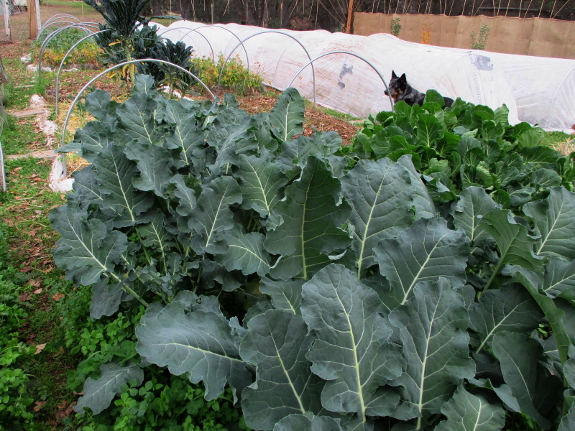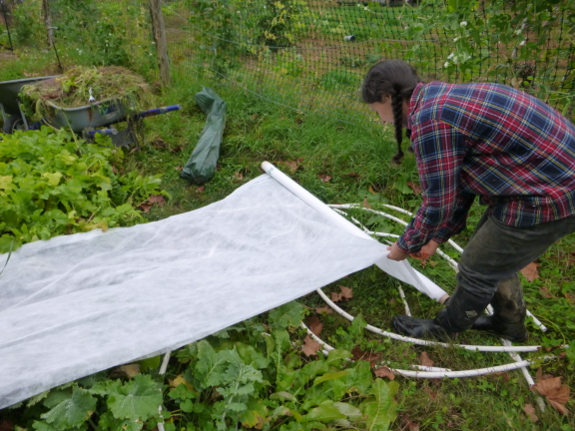
Weight and longevity of row-cover fabric

I hope you don't mind me sharing the photo above from your blog, Melina. I get this question a lot, so I thought the answer deserved its own post.
Eliot Coleman did some research with different fabric weights
and found that, counterintuitively, lighter-weight fabrics are actually
better at protecting the plants underneath. The heavier fabrics block
more sun, and it's really the sun-concentration effect that protects
your plants, not the night-time quilting effect. So, go for the thinnest
fabric, which in our experience (like yours) has been agribon-19. Yes,
it might not last quite as long, but it will do a much better job in the
interim.

I haven't done as much experimentation as Coleman has, but I did originally begin with thicker fabric, which I used on cold frames
instead of quick hoops. I've since retired that cloth, though, because
even though it doesn't tear as easily, it blocks way too much light to
leave on plants 24-7. If you feel you need an extra layer of protection
(which Melina shouldn't, but which northerners might), then a layer of
greenhouse plastic on top of the quick hoops during the coldest part of
winter will help. But you'll have to remove plastic during hot days
since, unlike row-cover fabric, plastic won't breathe!
Finally, I should briefly address Nayan's comment,
since she complained that her row cover fabric "didn't even last from
spring into summer. They literally crumbled into dust." Row-cover
fabric is
fragile, but if you take care not to tear it and always put it away
dry, I've found that the fabric easily lasts two years with no mending
and three-plus years if you're willing to sew a little. We definitely have not experienced any crumbling into dust!
Want more in-depth information? Browse through our books.
Or explore more posts by date or by subject.
About us: Anna Hess and Mark Hamilton spent over a decade living self-sufficiently in the mountains of Virginia before moving north to start over from scratch in the foothills of Ohio. They've experimented with permaculture, no-till gardening, trailersteading, home-based microbusinesses and much more, writing about their adventures in both blogs and books.
Want to be notified when new comments are posted on this page? Click on the RSS button after you add a comment to subscribe to the comment feed, or simply check the box beside "email replies to me" while writing your comment.

Thanks for the update on row covers. I had gotten brand new out of the plastic bag row covers and those were the ones that literally crumbled after about 3 months. A friend (who is now deceased) who was a professional chemist once told me that they now include corn starch in the plastic being produced because this causes the plastic to not last forever.
I now suspect that I had simply gotten a bad batch from the original supplier.
My main purpose for the row cover is to keep the blasted cabbage butterflies off the brassicas but I found that using old light-weight see-through curtains that I get from the thrift store works just as well and lasts a lot longer than a few years, and it's cheaper too!
Love your blog.
i really appreciate this kind of information, anna. thank you for sharing your knowledge and experience. i had wondered what role light transmission played---i think out here since i'm mainly using the fabric for a little extra push in growth during the colder part of the year anyway the more light getting in the better---very interesting that the lighter weight fabric works well at keeping things warm and protected in harsh climates. i think i'd benefit from reading a little more of coleman's stuff.
p.s. kind of neat seeing my photo on a well-known blog---especially a blog i enjoy so much.